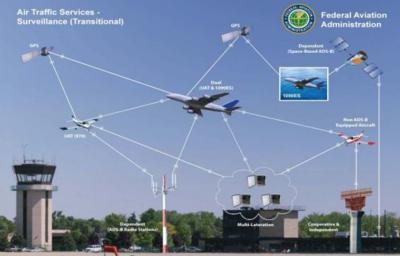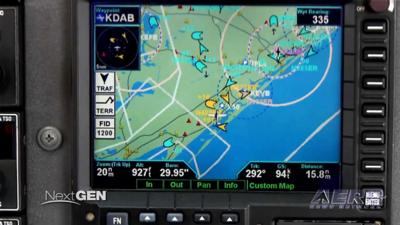Provides Step-By-Step Instructions For Participation
The FAA has released a fact sheet outlining details of the Rebate program being offered to GA aircraft owners in an effort to jump-start the conversion of general aviation airplanes.

The FAA says that Automatic Dependent Surveillance-Broadcast (ADS-B) is a foundational NextGen technology that transforms aircraft surveillance using satellite-based positioning. The ADS-B ground infrastructure is complete and operational today. Air traffic controllers across the nation are able to monitor aircraft using either ground-based radar or ADS-B.
The general aviation community will benefit greatly from ADS-B, but many operators have yet to equip their aircraft with ADS-B avionics. This equipment will be mandatory for all aircraft flying in certain controlled airspace beginning on January 1, 2020.
Benefits of ADS-B for General Aviation
General aviation and air taxi aircraft equipped with ADS-B Out enjoy more efficient spacing and optimal routing in some non-radar environments, including busy airspace in the Gulf of Mexico, mountainous regions of Colorado, and the lower altitudes of Alaska. Furthermore, general aviation pilots can receive Air Traffic Control services outside radar coverage due to ADS-B.
ADS-B improves life-saving search-and-rescue with accurate and timely last-reported positions.
Although not mandated, ADS-B In avionics and cockpit displays offer transformative services at no subscription cost to users.
These include:
- Cockpit displays of nearby air traffic for an environment of shared situational awareness with other pilots and controllers.
- Graphical weather displays to pilots to help avoid the dangers of hazardous weather and make better-informed decisions on most efficient routes (available on the UAT link only).
- Important aeronautical information from the Notices to Airmen, such as temporary flight restrictions or closed runways (available on the UAT link only).

Required ADS-B equipment for certain controlled airspace
The equipment used to broadcast GPS-derived location information, ADS-B Out, is mandated by 2020 for aircraft flying in certain airspace – generally the same busy airspace where transponders are required today. Aircraft that fly in uncontrolled airspace where no transponders are required, and aircraft without electrical systems, such as balloons and gliders, are exempt from the mandate.
To meet the minimum requirement for ADS-B Out, aircraft must be equipped with:
- An approved GPS receiver;
- An ADS-B Out system (extended squitter or universal access transceiver); and
- Antennas for the GPS receiver and ADS-B Out system.
Owners can install a minimal ADS-B Out system to meet requirements of the rule, or they can integrate with “ADS-B In” avionics and displays to reap additional benefits like cockpit displays that show free traffic, weather, and flight information.
When to Equip with ADS-B Out
Aircraft owners should equip as soon as possible to capture the benefits of ADS-B and ensure they will be able to fly in designated airspace when the rule is enforced on January 1, 2020. The FAA will not extend the deadline beyond that date.
The agency estimates that between 100,000 and 160,000 general aviation aircraft will need to equip with ADS-B Out. Unless equipage rates increase now, installation shops could be overwhelmed during the rush of the final two years. If too many operators wait, suppliers and installers will not be able to keep up with demand. This will result in a bottleneck of long wait times and possibly higher installation prices.
There are no obstacles now for owners to equip. All standards for certification and operational approvals have been in place since 2011. Additional guidance, such as operations specifications and guidance for field approval, also has been published. Approximately 1,100 certified repair stations are ready to install ADS-B avionics.

FAA Offers Rebates for New ADS-B Equipment:
To help avoid this last-minute rush and potential bottlenecks, the FAA is offering a financial incentive to owners of general aviation aircraft to encourage compliance with the ADS-B rule.
The aircraft eligible for rebates are defined as U.S.-registered, fixed-wing, single-engine piston aircraft.
In the fall of 2016, the agency will offer, on a first-come, first-served basis, rebates of $500 to owners of these aircraft, based on their purchase of avionics that are certified to FAA Technical Standard Orders and meet the requirements of the 2010 rule, and so long as funding is available. An aircraft owner will be limited to one $500 rebate.
Accelerating compliance with the 2010 rule is critical to ensuring that pilots, manufacturers, and retail facilities have adequate time and capacity to equip aircraft in a timely and efficient manner, ahead of the 2020 regulatory deadline.
Based on the total funding available for this effort, the agency will be able to distribute 20,000 rebates. The FAA will issue rebates on a first-come, first-served basis for one year after the program is launched in fall 2016 or until all 20,000 rebates are claimed, whichever comes first.
The FAA will not offer rebates for software upgrades for aircraft already equipped, for new aircraft, or for aircraft for which the FAA already has paid or committed to upgrade.
Rebate Program Key Elements
Timeframe: Approximately one year after the program is launched in fall 2016 or until the funds for all 20,000 rebates are exhausted, whichever comes first.
Aircraft: Existing fixed-wing, single-engine piston aircraft. Aircraft first registered after January 1, 2016 (new aircraft) are not eligible.
Equipment: Avionics that are certified to FAA Technical Standard Orders and meet the requirements of the rule (14 CFR paragraphs 91.225 and 91.227). Software upgrades of existing equipment are not eligible. Rebates are not available for aircraft already equipped or for which the FAA already has paid or committed to upgrade.
Proof of equipage: Within 60 days of the planned installation date, aircraft must be flown in "rule airspace" as defined in 14 CFR 91.225 for a minimum of 30 minutes with at least 10 aggregate minutes of maneuvering. In Alaska, Guam, Hawaii and Puerto Rico, flight of an Eligible Aircraft above 10,000 feet MSL and within FAA ADS-B coverage will qualify as meeting the airspace requirements of this program, even though this airspace is not included in 14 CFR §91.225.
Rebate Steps:
- Decide: Owner schedules the installation of the Technical Standard Order (TSO)-certified avionics for an eligible aircraft.
- Reserve: The owner reserves a rebate from the FAA’s ADS-B Rebate website for each Eligible Aircraft before avionics installment occurs.
- Install:The TSO-certified ADS-B avionics are installed on the eligible aircraft.
- Fly & Validate: Not later than 60 days after the installation, the aircraft must be flown in “rule airspace” as defined in 14 CFR 91.225 for a minimum of 30 minutes with at least 10 aggregate minutes of maneuvering (AC 20-165B contains flight maneuver recommendations). After the flight, the aircraft owner must validate the performance of the Eligible Aircraft’s ADS-B installation by requesting a Public Compliance Report available on the FAA’s ADS-B Rebate website. A validated installation will provide the owner with an incentive code.
- Claim: Not later than 60 days after the installation date, the aircraft owner gathers their Rebate Reservation Code and Incentive Code and navigates to the ADS-B Rebate website to claim the rebate.
To help get the word out, the FAA is partnering with the Aircraft Owners and Pilots Association, the Aircraft Electronics Association, and the General Aviation Manufacturers Association. The agency will publicize the rebates at major conferences and events that are geared toward general aviation, and will establish a website with program details and a contact for questions and concerns.
The rebates will be available this fall, and the FAA will announce the specific date soon. In the meantime, the FAA is encouraging aircraft owners to look at the available equipment on the market and to schedule an installation appointment with a qualified installer starting in the fall of 2016. Aircraft owners will only qualify for the rebate if the installation is scheduled after the FAA begins offering the rebates.
(Source: FAA)
 ANN's Daily Aero-Linx (04.15.24)
ANN's Daily Aero-Linx (04.15.24) Classic Aero-TV: 'No Other Options' -- The Israeli Air Force's Danny Shapira
Classic Aero-TV: 'No Other Options' -- The Israeli Air Force's Danny Shapira Aero-News: Quote of the Day (04.15.24)
Aero-News: Quote of the Day (04.15.24) Airborne 04.16.24: RV Update, Affordable Flying Expo, Diamond Lil
Airborne 04.16.24: RV Update, Affordable Flying Expo, Diamond Lil ANN's Daily Aero-Term (04.16.24): Chart Supplement US
ANN's Daily Aero-Term (04.16.24): Chart Supplement US





